We’re currently undergoing a low-key fighting game renaissance. Last year’s Street Fighter V finals at Evolution were shown on ESPN 2 for the first time, SNK made a triumphant return with The King of Fighters XIV, and Guilty Gear is still going strong. On top of that, Injustice 2 has released to rave reviews, Mortal Kombat X was the best-selling game of its franchise, Tekken 7 has finally come out for consoles, and we’ve still got Marvel Vs. Capcom: Infinite on the horizon.
There are more people trying to get into fighting games than ever before, but like any genre, fighting games have their own specialized slang. You may have noticed it yourself; if you try to read a subreddit or forum thread about a game you’re interested in, it can be like fighting-game fans are speaking an entirely different language.
This is intended as a guide for beginners as a way to get a handle on some of the common terms used by the fighting game community (FGC). Even a relatively simple modern fighting game can be complicated for a newcomer, and that’s bad enough without also having to pull out a decoder ring to figure out what your fellow players are saying.
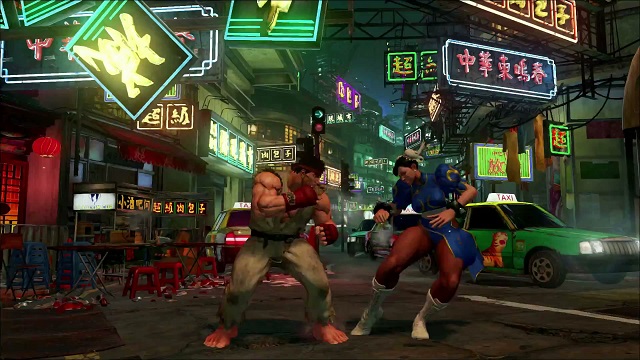
FGC Notation
Here’s where the first problem usually kicks in. Click on a link for a fighting game you’re interested in, and here’s something that they might list as “basic”:
j.S -> st. M -> st. H -> b, d, db + L -> j. M -> j. M -> j. S -> st. M -> st. H -> DP + H
That’s an ostensibly beginner-level combo for Spider-Man in Ultimate Marvel vs. Capcom 3. (There are a lot of hits in it. UMVC3 is just that kind of game.) If you’re coming at the game cold, it looks like gibberish.
Every fighting game typically has its own unique button scheme. There may be a crossover between franchises from a single publisher, too; for example, Street Fighter and DarkStalkers both use the same six-button layout, although their mechanics differ. In general, however, each game will have its own style of notation, the most basic of which starts from the joystick:
b – back
f – forward
d – down
u – up
Naturally, “back” and “forward” are always relative to your character, who will almost always be facing your opponent.
Combinations of these notations are used to indicate diagonals, so, for example, d/f is down and towards the opponent.
To make things a bit more confusing, some Japanese players will use numbers here instead, which dates back to old-school BBS days. To translate, look at the number pad on a standard computer keyboard. The numbers correspond to the joystick direction. For example, 1 is down/back, 2 is down, and 3 is down/forward. Let’s just stick to Western notations for now.
j. — jumping
sj. — super-jumping, where applicable
cr. — crouching
st. — standing; neutral position
XX — often used to indicate canceling one move into the next
If there’s nothing at all in front of a button, you can comfortably assume that it means a standing or neutral move.
Individual buttons will differ widely enough between games that we’d be here all day if we tried to discuss them all specifically. Fortunately, this is one of the easiest things to figure out if you’ve got the game in front of you, although you’ll still run into an occasional naming convention among different online fans. Still, you’ll have to go game by game on this one.
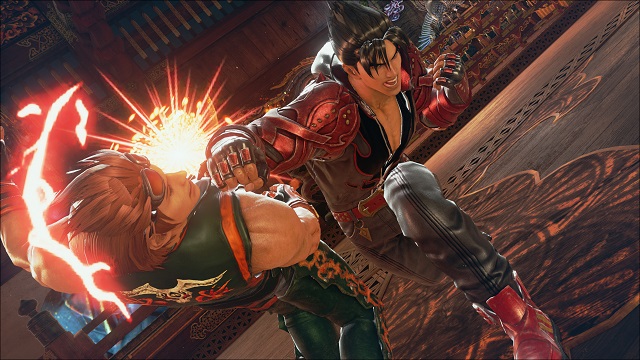
Basic Fighting Game Terms
We should probably start with these, as they’re the heart of most fighting games’ systems.
Meter
There’s some form of resource meter built into most modern fighting games. Typically, this meter fills up gradually when you get hit or land a hit, and is spent on using super moves, enhanced special attacks, or other useful mechanics.
This may seem obvious — after all, the meter’s right there in the UI, it’s generally always in the same place from game to game, and some kind of gradually-building resource has been a regular fighting game mechanic for almost twenty years — but this is meant as a list for beginners, after all, and meter management is a huge part of any fighting game it’s in.
This goes doubly for games like Street Fighter V, where there’s more than one similar resource to keep track of, or Mortal Kombat X, where your X-ray, EX moves, and breaker all run off the same meter.
EX Move
This is a mechanic where you can opt to spend some super meter when you use a special move in order to enhance that move in some predetermined way. This may mean it does more damage, hits another couple of times, or has some additional tactical utility. For example, Johnny Cage in Mortal Kombat X can spend some of his meter on his energy ball in order to throw two of them at once.
This is also known as “meter-burning” or as an enhanced move, but fans often call this sort of thing an EX Move, after its name in the DarkStalkers and Street Fighter franchises.
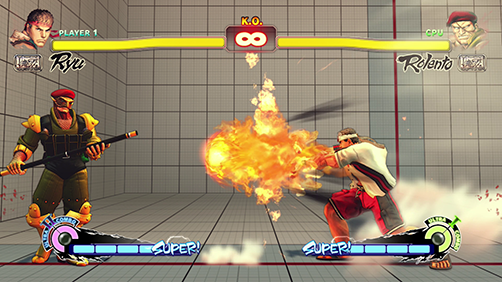
Ryu’s EX Hadoken in SFIV hits twice.
Normal Move
These are the most basic attacks you can do. Normals are what come out when you push a punch or kick button while standing, jumping, or crouching.
A “command normal” requires you to use simple joystick commands in conjunction with an attack button. These aren’t typically as elaborate as special moves but do give you some extra options.
Special move
These moves are more complicated trademark attacks of a character, which are performed with the combination of a joystick motion and an attack button. These are your fireballs, teleports, fancy throws, and special punches or kicks. They form the spine of your character’s strategy.
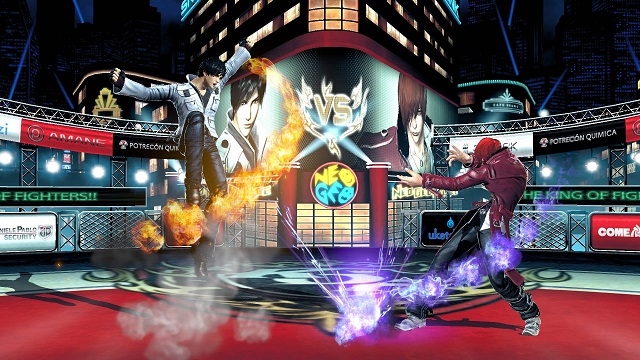
Super
It often has a more spectacular official name, such as a Desperation, a Super Art, or an Overdrive, but they all mean the same thing. A super move is a damaging, often multi-hit attack that costs a substantial amount of meter to perform. In games that include supers, they are often where much of your damage ends up coming from.
Slightly Less Basic Terms
This is by no means exhaustive; a full list of all the slang in the FGC would be enough for a short book, and it would likely be out of date within a few days to a week depending on when Yipes next goes on stream. It also tries to shy away from terms that are overly specific to one game or one community.
Airdasher
A common term in the community for a particular subgenre of well-animated, often insane Japanese fighting games, such as Guilty Gear, BlazBlue, and Persona 4: Arena. Also known as anime fighters or anime games.
Anchor
In team-focused games, this is the last character in your team order, and thus, the one who you’re going to fall back on when you’re about to lose the match. Less frequently, it’s also used as an adjective to refer to the last character standing on a player’s team (“anchor Vergil”).
When choosing a team, it’s generally a good idea that your anchor is a character that A.) you’re good with, and B.) has particular abilities that scale well with whatever comeback mechanics are built into the game. In King of Fighters XIV, your anchor should be a fighter who benefits from higher meter capacity, like Robert; in Marvel vs. Capcom 3, anyone can be a decent anchor, but the best are characters who are already fast and mobile, so they turn into absolute nightmares when you activate X-Factor.
Anti-air
An attack that is either intended or which is used to counter an incoming attack from above, such as a jump-kick. Ryu’s and Ken’s Shoryuken is the most well-known example.
Armor
A passive ability that allows a character to ignore the impact of one or more incoming hits. Armor allows you to go straight through an enemy attack in order to connect one of your own. You’ll still take the damage from it, but your character won’t flinch.
Armor may be a passive ability that a character possesses (Juggernaut in Marvel Super Heroes) or applied temporarily by certain special moves (enhanced special attacks in Mortal Kombat X). If a character can ignore more than one hit before flinching, that’s sometimes called super armor; if a character simply will not react at all when struck, regardless of how often they’re hit (Hsien-Ko’s gold mode in Marvel vs. Capcom 3), that’s sometimes referred to as hyper armor.

Enhanced moves in MKX often get a single hit of armor.
Some older games have a similar mechanic, auto-guard, where an enemy attack that connects during a given special move is treated as though it was blocked.
Battery
This refers to a character that’s good at generating resources, like super meter, but who doesn’t necessarily need to spend them to be effective. Their role on a team is to build those resources so another character can use them.
In team-based games like King of Fighters, it’s helpful to have a battery character in the first or second spot on your team, as if that character gets knocked out, it positions your next character to come in with plenty of available meter.
Beam super
A generalized term for any super attack that takes the form of a giant, screen-filling projectile of some kind.
Bread and Butter Combo
A simple combo that a character will use all the time. Like the name suggests, it’s basic stuff, and part of picking up a new character involves mastering or coming up with some bread and butter combos. Often abbreviated as B&B or BnB.
Blockstun
The split-second following a successful block in which a character is stuck in his or her blocking animation.
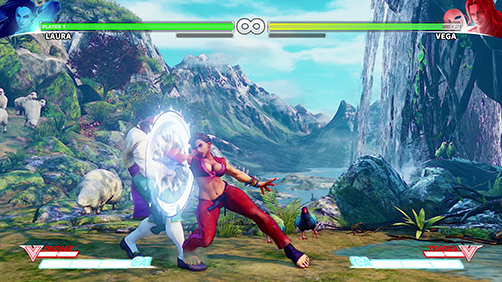
It’s difficult to take a screenshot of Laura that doesn’t
look like I’m doing it for the sake of fanservice.
Some games have mechanics that allow you to cancel this state into an attack or end it early, such as the Just Defense system in Garou: Mark of the Wolves or guard cancels in the King of Fighters series.
Breaker
A move you can use while you’re getting hit. Your character breaks out of your opponent’s combo, allowing you to regain momentum. This will typically cost you some amount of resources to perform, such as super meter. They’re a well-known feature in the Killer Instinct games, but made their debut in the Mortal Kombat franchise in MK vs. DC Universe.
Cancel
Interrupting one move by entering the input for another. This forms the basis of many games’ combo systems.
Charge character
A character whose special moves mostly or entirely involve holding back or down for a second, then pushing forward or up in conjunction with an attack button.
Guile in Street Fighter II is the archetypical charge character, but most 2D fighting games will have at least one on the roster somewhere.
Chicken-guard
When you jump up to deliberately block a move while you’re in mid-air. When your character lands, you come out of your block animation early and can retaliate just a little bit faster.
Obviously, this only works in games where you can block in mid-air. It’s most commonly seen in the Marvel vs. Capcom series.
This link is NSFW (content warning: announcers swearing/having a lot of fun with this), but skip to 5:21 for a perfect example of chicken-guarding. Since Chris blocked Nova’s super in mid-air, he recovered from blockstun upon landing and could instantly retaliate, ending the match.
Cherry tap
To knock out an opponent with one of your weakest attacks.
The term comes from the Street Fighter Alpha series, where when you won a round with a jab or short kick, your victory icon was a pair of cherries. This went on to appear in a couple of later games, such as 1995’s Marvel Super Heroes.
Chip damage
A slight amount of damage that gets inflicted through a successful block. In most fighting games, normal attacks do not inflict chip damage, while special attacks do; however, a few games, most notably the Mortal Kombat franchise and Street Fighter V, have universal chip damage on block.
This is also sometimes referred to as cheesing. As with cherry tap, above, you got a block of cheese as your victory icon in Street Fighter Alpha if you knocked out an opponent with block damage.
Cinematic
An attack, usually a super, that takes the form of a short, non-interactive animated sequence. They cannot be interrupted once they begin, and some will even stop the round timer while they’re playing.
Examples include the supers in the Injustice games, Ultra Combos in Street Fighter IV, or Spencer’s Bionic Beatdown in Ultimate Marvel vs Capcom 3.

All you can do is watch the show.
Combo
A series of attacks in a row. How you achieve a combo will differ markedly from game to game, but in general, basic combo mastery is the first step in learning a new fighting game.
Command throw
A particular type of special move or super. Command throws typically cannot be blocked and inflict heavy damage, but leave you wide open if they miss. The ur-example is Zangief’s Spinning Piledriver.
Cross-up
An attempt to circumvent an opponent’s defense by attacking from an unexpected direction, so they don’t immediately know where you’re coming from and will have a hard time blocking you.
DP
An informal slang term for a special move that involves some kind of jumping uppercut or kick, usually used as an anti-air. Named for Ryu and Ken’s Dragon Punch (a.k.a. the Shoryuken) in Street Fighter II, which spurred countless imitators both in the Street Fighter franchise and elsewhere.
DP can also refer to the trademark joystick input — down, forward, down-forward — for a Shoryuken. Many fan-created move lists will use DP (or SRK) as shorthand for it.
Footsies
This refers to when both players are testing out each other’s defenses and trying to find an opening. This often involves a lot of long-range kicks, hence the name; in some games, such as Street Fighter IV, an extended period of footsies looks a lot like both characters are trying really hard to kick one another in the shins.
Frame Advantage
Frame advantage discusses how quickly a character becomes directly controllable again after a given action or reaction, measuring it in the number of frames of animation it involved. The more of a frame advantage you have, the faster you recover after a given action, and at the tournament level, players frequently build their strategies around manipulating frame advantage.
This is what fighting-game fans are talking about when they refer to a given move as “plus/minus on block.” It’s a specific, precise way to discuss a move’s activation and recovery time.
Frame Data
A measurement of how many frames of animation a given move lasts, which illustrates its response and recovery time. High-level players will often analyze frame data as a method of determining what moves to use in a given, specific situation, especially when they’re trying to figure out a particular character match-up.
There are a number of ways to determine frame data, such as strategy guides, in-game tutorials, third-party analysis tools, or mods for a game’s PC version.
Note: Frame data and frame rate are not the same thing. Frame rate is how fast the game is running; frame data is a relatively number-crunchy way to analyze characters’ reaction speeds.
Frame Trap
An advanced tactic in which you’re deliberately trying to bait your opponent into a counterattack, because it looks like you left yourself open. It’s a mind game, because, in an ideal frame trap, you’re using your character’s skills to feign vulnerability.
A typical example: You’re raining down hits on your opponent, who blocks them all, but you leave just enough of a gap between one hit and the next that he thinks you’re done and tries to stick out an attack of his own. He is mistaken.
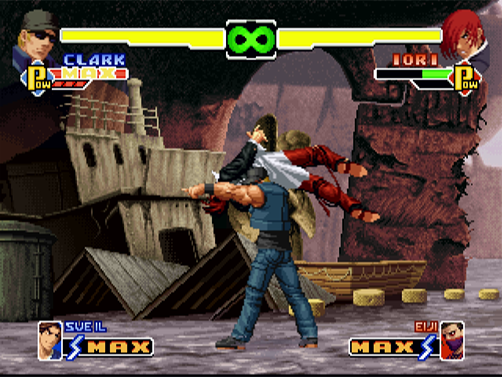
Hitbox
The part of a character that can interact with an opponent, whether it’s by hitting or being hit. Hitboxes are invisible in a typical retail copy of a fighting game, but they can be revealed via mods or developer codes. Studying them can tell an advanced player a lot about how the game works, as a character’s moves may temporarily grow, shrink, or outright remove their hitbox.
Alternatively, there’s a type of highly specialized all-button arcade stick called a Hitbox, which some players swear by.
Hit confirm
To successfully turn an attack into the start of a combo. Also known as a conversion.
Hitstun
The period of time immediately after being struck when a character cannot act.
Invincibility frames
A window in which a character cannot be hit at all. Some characters have special moves that provide invincibility frames, and knowing when to use them is a big part of that character’s strategy. For example, Haggar in Ultimate Marvel vs. Capcom 3 is a common team pick entirely because his Spinning Lariat assist has a lengthy period of invincibility, which lets him stop enemies in their tracks.
Launcher
An attack that, if it connects, knocks a character into the air in order to start a combo.
Meaty
Timing an attack on an opponent so it hits as late in its animation as possible, typically while the opponent is standing back up. This is a method of gaining frame advantage.
Meterless
Damage you inflict without having to burn any meter on it.
Mirror Match
A round in which both players are using the same character. Named after one of the later fights in the original Mortal Kombat‘s arcade mode. Sometimes simply called a “mirror.”
Negative Edge
In a fighting game that has negative edge, its systems allow you to input special attacks by either pressing an attack button or letting go of one.
At a beginner level, this is likely why your attacks aren’t working the way you want them to. At an advanced level, you can use negative edge to save a split-second on your inputs, which lets you pull off combos and tactics that would otherwise be impossible.
Relatively few games have negative edge. Recent examples include Street Fighter IV and Mortal Kombat 9.
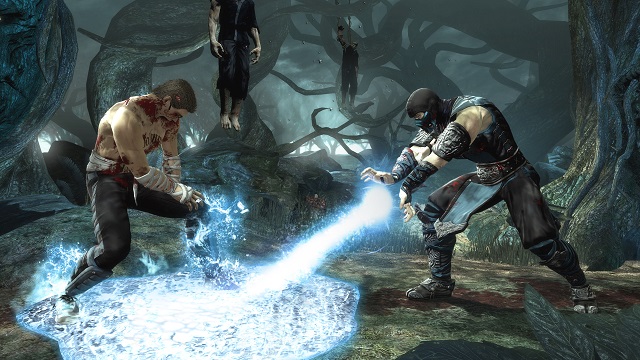
Okizeme
Also abbreviated as “oki.” A portmanteau of the Japanese words for “to wake up” and “to strike.” See wake-up.
OTG
“Off the ground.” Moves or attacks which strike a character who’s lying prone, knocking him or her into the air for further punishment.
Some older games called this a “pursuit” move, although there, it’s typically limited to a single hit.
Overhead
An overhead, or a move that hits overhead, cannot be blocked from a crouching position.
This is designed to allow an attacker to get in on a defender who’s simply crouching in the corner. Before the implementation of overheads, if an opponent simply spent the entire match holding down-back, there wasn’t much an attacker could do about it.
Poke
A medium to long-range attack meant to test your opponent’s defenses.
Priority
A vaguely controversial term that regards a given attack’s chance to hit. It doesn’t actually involve any math or random chance; instead, a “high-priority” move might have a bigger hitbox or temporarily move a character’s hitbox out of harm’s way.
Raw
A move done all by itself. You didn’t combo into it or do anything to set it up; you just threw it out there. It will be extremely impressive if it hits anything. Sometimes it’s worth doing to inflict some block damage, though.
Reset
To deliberately let a combo end so you can immediately start another one. High-level players will do this in order to get around the way that damage scales with the length of a long combo.
Runback
A rematch. Most commonly used to refer to one player earning a rematch against another player who’s already beaten him or her once in the same tournament.
Safe
An attack that doesn’t leave you at a potential disadvantage, such as a quick jab. You can throw safe attacks out all day and your character will recover in plenty of time to block or avoid an incoming counter.
Salty
A common term in the larger FGC, used to denote dissatisfaction, typically from a match that didn’t go your way. This is why one of the most common reactions to a sore loser in FGC Twitch streams is an emote of a spilled container of table salt.
Shoto/Shotoclone
A character that looks and plays similarly to Ryu and Ken in Street Fighter, who both practice Shotokan karate.
A lot of subsequent fighting games used the general Ryu/Ken moveset as a kind of shorthand for its protagonist or its entry-level character. There are also a lot of similar or related fighters in later games in the Street Fighter franchise, such as Akuma, Sean Matsuda, Dean Snider, and Dan Hibiki.
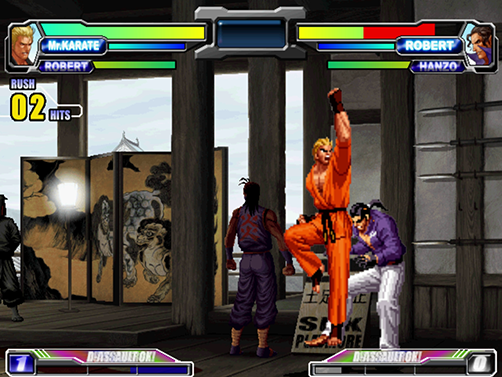
Not Ryu or Ken, but an incredible simulation.
Taunt
A special move, traditionally mapped to the Start button on arcade cabinets, where your character leaves him- or herself open in order to jeer at the opponent.
This is basically a way you can show off, although some games’ taunts have additional capabilities. For example, Street Fighter III: Third Strike gives every character a short-lived buff after a successful taunt, Eternal Champions‘ taunts drain your opponent’s chi meter (yeah, we mentioned Eternal Champions; old-school cred firmly achieved), and taunting an opponent right before you win a round in Guilty Gear Xrd -SIGN- means they start the next round with 50% Tension.
Tech hit
To break out of an attempt at a normal throw.
Tick-throw
Using a quick attack, such as a light punch or kick, to set an opponent up for a command throw. Ideally, either the attack hits and you can use it as the beginning of a combo, or they block the attack and you land the throw while they’re stuck in blockstun. Tick-throws are a big part of the game for anyone who’s playing a wrestler or grappler.
Tiers
Typically used in discussion of character matchups, “tiers” are an entirely arbitrary method of ranking characters’ abilities. High-tier characters have many solid advantages; lower-tier characters are flawed in some significant way.
This is sometimes also discussed in terms of numerical match-ups. For example, if a character is said to be 6-4 against another character, assuming an equal amount of skill on both players’ parts, the first character should confidently expect to win six out of every ten matches.
There is very little hard data behind tier lists, most of the time, and each one generally comes down to the writers’ opinion. They can be an interesting point of discussion, as a game’s tiers usually give you a good idea of what the competitive players are thinking, but if you’re strictly a casual fan, you can (and probably should) ignore them altogether.
Trade
When both characters take damage at once; taking damage in order to inflict greater damage or gain a positioning advantage.
Unsafe
A move with a lengthy recovery time. If it misses or is blocked, you’re leaving yourself wide open.
An unsafe move is generally high-risk, high-reward; throwing it out randomly is a bad idea, but if you figure out how and when to use it, it can be powerful. The Shoryuken, for example, is notoriously unsafe.
Wake-up
A general term that surrounds what you do when your opponent or your character have been knocked down. Also known as okizeme or oki, as above.
The wake-up game is a big part of any fighting game, although some, such as the Tekken franchise, make it more important than others. At its heart, the wake-up game is about how you use the advantage you’ve gained by knocking your opponent down, or conversely, how you recover momentum after getting knocked down yourself.
Wall bounce
A heavy attack that throws its target backward into a wall or the corner of the screen, allowing for follow-up attacks while they’re recovering from the impact. This is also frequently called a wall splat.
Some games also allow you to inflict a ground bounce, which is exactly what it sounds like.
Zoner
A character built around controlling space and making him- or herself difficult to approach. This typically involves a wide variety of projectiles and ranged attacks. A perfect round for a zoning-based character is one in which their opponent was unable to get anywhere near them.
Zoners tend to make people angry, especially early in a game’s life (such as Full Auto Jacqui in the first few weeks after Mortal Kombat X came out), but eventually most people figure out their tricks. They’re great in the first month or so, but after that, tend to fall out of regular use.
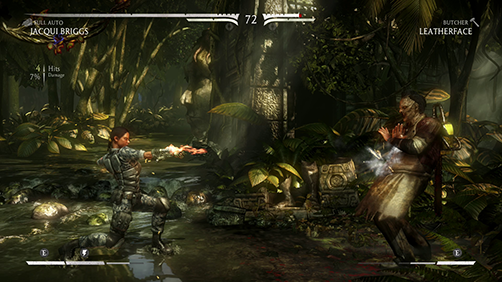
Even the sound of her gunshots still makes people angry.
Nowhere Near Done
This should be enough to get you started on a general level. If there are other terms you’d like to have explained, feel free to mention them in the comments below.
Fighting games can have a big learning curve, but they’re one of the most social parts of this hobby, and you’ve probably got a local scene near you. Be ready to lose your first few (hundred) rounds, keep learning, and keep adjusting.

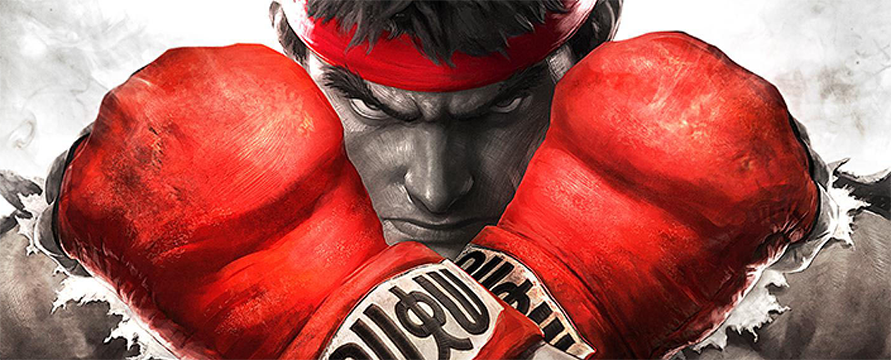



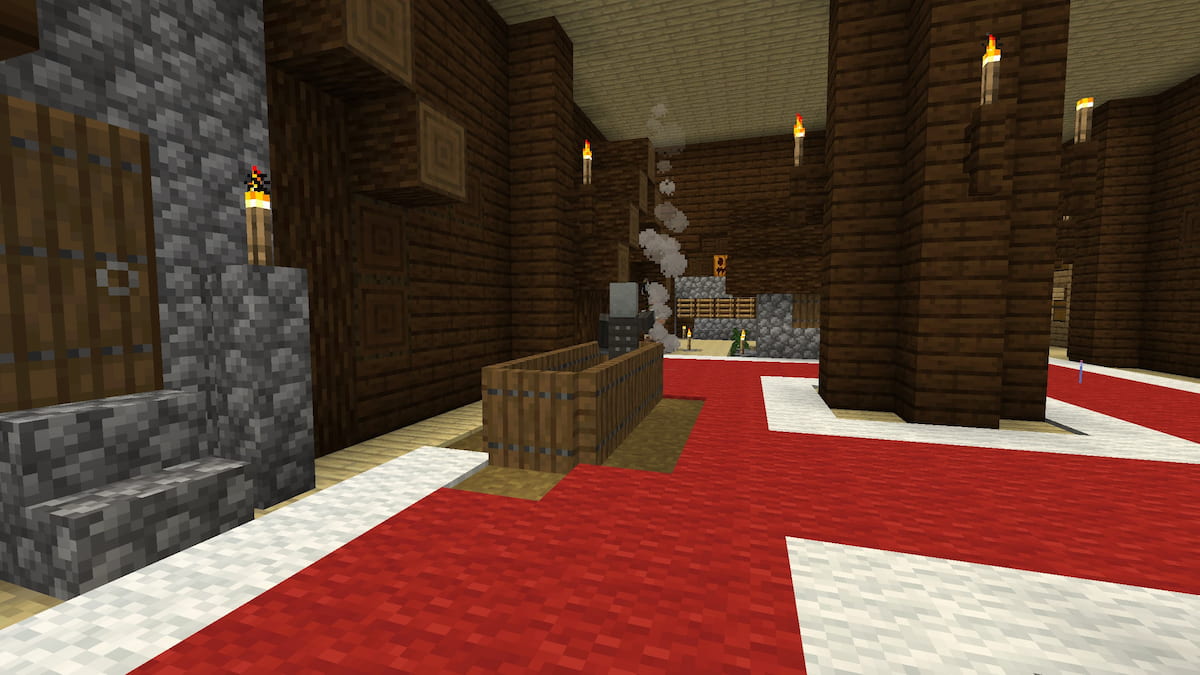
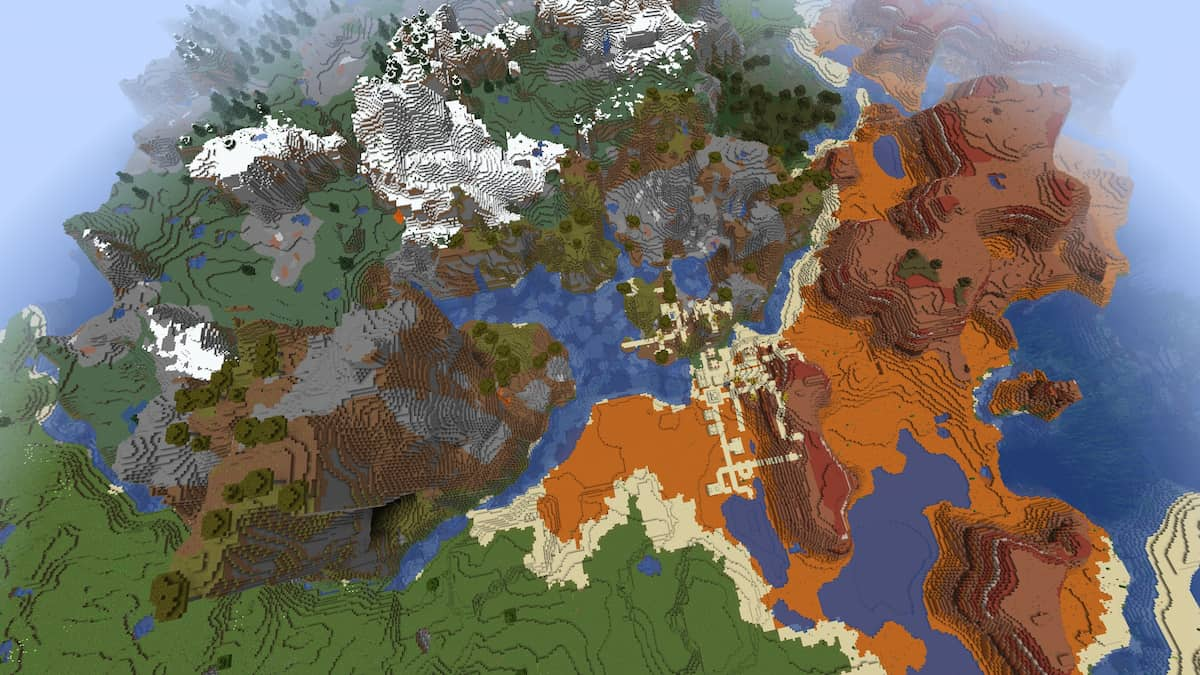
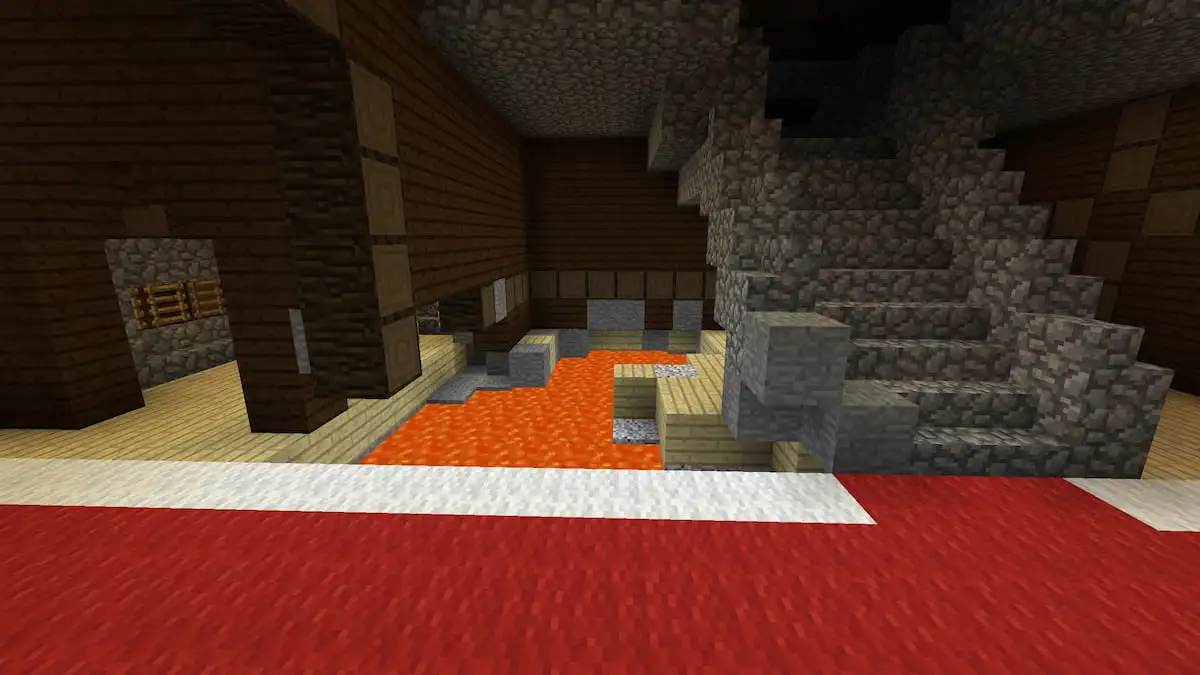
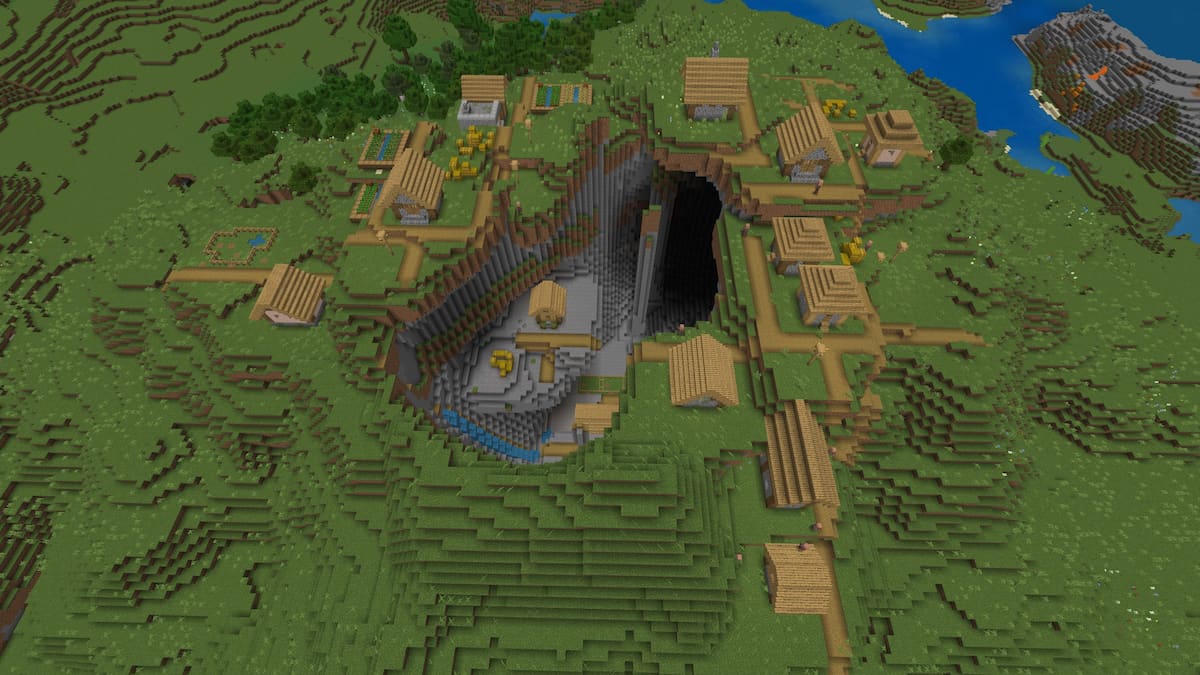
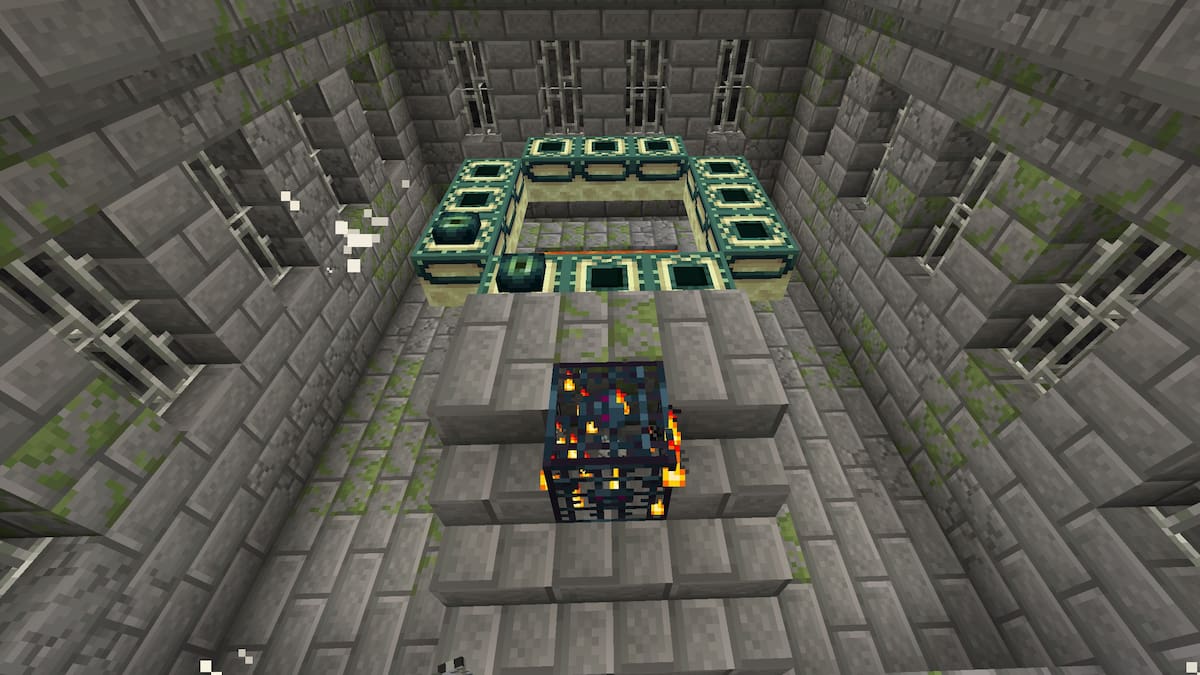
Published: May 27, 2017 07:08 pm